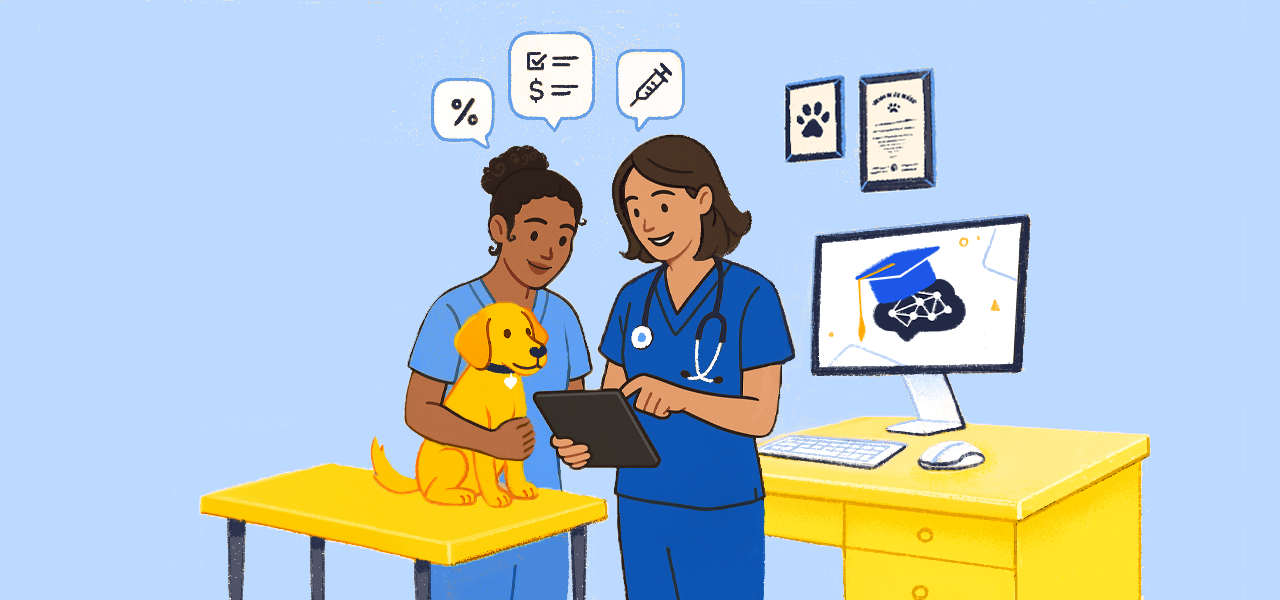You finally filled a key role in your veterinary practice. Now you’re wondering how quickly they can learn your practice management software and how much support they’ll need from your already overloaded team.
Sound familiar?
Most veterinary hospitals don’t realize the impact software onboarding can have—not only on new hires but also on the whole team. It can shape everything from job satisfaction to client trust (and even patient outcomes).
Get it right, and you set the tone for confidence and consistency. Get it wrong, and the ripple effects—missed details, stalled workflows, frayed nerves—can quietly undermine your entire hospital.
When onboarding breaks down, it’s rarely about effort. Most veterinary teams are doing their best under pressure. The deeper issue? The software systems they rely on weren’t built with real-world hospital workflows (or training needs) in mind.
At Instinct, we work with some of the world’s busiest, most detail-oriented hospitals. We’ve seen firsthand how outdated tools and limited access to support can drag down even the strongest teams. But it doesn’t have to be that way.
Here’s what we’ve learned and how it can help your hospital build a smoother, smarter training program and experience.
The Training Bottleneck No One Talks About
Adding a new team member should feel like relief. But we’ve all had those moments when it feels like chaos multiplied.
It’s easy to blame the learning curve. Too often, there’s a deeper problem: your software is harder to teach than it needs to be.
Every veterinary professional has faced this at some point in their career:
- A technician shadowing a 10-year veteran who can’t pause long enough to explain each click (and there are a lot)
- A new receptionist who’s told, “Just play around and let me know if you have questions”
- A floating ER nurse who’s too afraid to ask how to add an order, guessing and hoping they don't miss anything critical
When software feels like a black box, every click becomes a risk. And every risk chips away at your team’s confidence.
If this sounds familiar, it’s not your fault or your team’s. It’s a sign your tools weren’t built for the way your hospital actually works. And that’s a fixable problem.
Good medicine depends on good systems. Good systems depend on good training.

Why Veterinary Software Onboarding Fails (and What Happens When It Does)
Here’s the hard truth:
- Most trainers are too busy to teach systematically
- Most legacy systems weren’t designed to be intuitive
- Most new hires are too busy (or too anxious) to admit when they need more support
When that happens, small gaps become big problems:
- Treatments aren’t documented correctly
- Client communications get missed or misfiled
- Invoices go out incomplete or inaccurate
- Staff morale starts to erode, one friction point at a time
Even the most promising new hires can stall because of poor software onboarding. Without a clear system, confidence dips, mistakes happen, and valuable team energy gets lost to preventable errors.
How Top Veterinary Hospitals Train for Software Success
The good news is that training doesn’t have to be overwhelming. It doesn’t have to come with a 50-page manual or a week off the floor.
It just has to be intentional (and tailored to the way veterinary hospitals actually run.
Here’s what the most successful Instinct customers do differently:
1. Prioritize the first 5 workflows.
New hires don’t need to master every feature by Friday. They need to confidently handle the daily tasks that move patients through the hospital safely:
- Intake and triage
- Treatment plan building
- Estimate generation and updating
- Client education and communication
- Checkout and payment processing
At Instinct, we design our workflows to mirror real hospital priorities, not theoretical processes, so we recommend training with real cases as soon as possible. When a new veterinary technician successfully admits their first patient solo or a CSR confidently finalizes an invoice, you’ll feel the change.
They're not just surviving the shift. They're starting to own it.
2. Use micro-certifications, not just job shadows.
Watching a senior technician fly through the software might be impressive, but it’s not training.
Hospitals that achieve long-term success set up small, meaningful checkpoints with new hires to build competence step-by-step:
- Can you create and modify a treatment plan?
- Can you create an estimate for a patient?
- Can you finalize an invoice and complete discharge paperwork?
That’s why Instinct hospitals love our learning management system (LMS), which features brief, practical courses that help you build a strong foundational understanding of our practice software. (And it’s quick, too! Our LMS is designed for micro-learning, so you can get through a course in 30 minutes or less.)
💡 Bonus: Use Student Mode for safe, supervised learning.
Instinct’s Student Mode is a special draft environment that lets new team members practice building treatment plans with a safety net. No orders go live until reviewed and approved by a user with approval power.
It’s the perfect way to:
- Encourage hands-on learning without the risk
- Give new hires autonomy while still allowing oversight
- Support trainers and medical leads with a built-in review process
Regardless of your trainee’s role, Instinct’s Student Mode makes “learning by doing” safer, faster, and less stressful.
3. Make training hands-on.
Nobody learns a veterinary PIMS just by reading PDFs and watching webinars. (And let’s be honest, who has time?)
Instead:
- Assign real tasks with real patients
- Shadow, then reverse-shadow (“You do it while I watch”)
- Debrief mistakes (even small ones) immediately, before they snowball
For example:
- New tech or nurse? Have them complete and record treatments due for a pet.
- New CSR? Have them send a client handout from Plumb’s about managing a new prescription.
When your software has embedded client education tools, real-time treatment sheets, and simple estimate workflows (like Instinct), hands-on training becomes the default, not the exception.
4. Connect the clicks to the ‘why’.
“Click here. Now click here.” is more recipe-following than training. Effective onboarding connects every action to a purpose:
- We document treatments in real-time so no meds get missed.
- We send estimates early to build client trust and prevent billing disputes.
- We chart discharges carefully because owners won't remember half of what we say at pick-up.
When new team members see how their clicks impact patient outcomes, client experiences, and hospital revenue, they care more, engage more, and stay longer.
Good onboarding goes beyond training skills and fosters a sense of ownership.
If Your Software Isn’t Helping You Train, It Might Be Hurting You
You shouldn’t need a 6-week boot camp to get a new hire through a shift. You shouldn’t have to memorize 10 workarounds to document a simple patient discharge. Your software should make the onboarding process easier, not harder.
It’s why we built Instinct the way we did: intuitive, clinical-first, and designed for real-world hospital workflows. When your tools support great onboarding, everything else gets easier.
Ready to See the Difference?
If your team is still training around the software instead of with it, it’s time for a change.
Instinct was built to support how your hospital actually works—making training smoother, onboarding faster, and every shift a little less stressful.
Want to see how it all comes together?
👋 Let’s talk. Book a call with our team and see Instinct in action—no pressure, just a real conversation about your goals and how we can help.
👉 Request a Demo →

